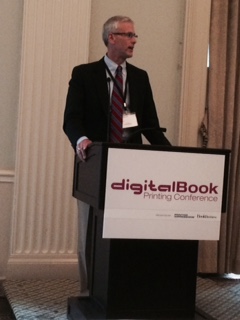5 Takeaways from the Digital Book Printing Conference
Industry News
More articles »
5 Takeaways from the Digital Book Printing Conference

LBS was proud to be a sponsor of the recently held Digital Book Printing Conference in New York City. The setting was the historic Union League, where we were surrounded by floor to ceiling stacks of printed and bound books…none of them printed digitally we can assure you! So it was in this setting that all of today’s leading digital print equipment manufacturers explained to us how easy it is to print one book at a time; beautifully, accurately, and affordably.
As a sponsor, LBS had a table full of samples, displaying our complete line of bookbinding materials including cover materials, endsheets, reinforcing materials and our exclusive PrimeOne board. It was a very successful day for publishers, book manufacturers and suppliers to discuss today's issues of how to manage the challenges and take advantage of the opportunities of printing and binding books on demand.
Marco Boer, long-time printing consultant and emcee of the Digital Book Printing Conference, highlighted these top 5 takeaways...
- “Culture eats strategy for breakfast.” By this, Boer meant that book publishers must embrace significant cultural changes in order to fully embrace digital printing and reduced inventory models. Rather than managing warehousing, inventory, and shipping themselves, publishers must learn to trust book manufacturers to handle these expenses. And book manufacturers, Boer added, have to prove to publishers that they have the capability to take on inventory and distribution.
- “The savings from digital printing are very real for book publishers.” This was evident during a panel featuring James Gaskin director of content, publishing technology, and production at the Practicing Law Institute (PLI) and Nora of Reed Elsevier. Both panelists said that by altering their internal structures to easily transmit book files to printers, they have set the stage for significant savings through digital printing. Gaskin described it as the “$90,000 door,” the door that connects the manufacturing and distribution departments, saving PLI $90,000 a year in shipping costs.
- “Book manufacturers are responsible for educating book publishers [about digital printing].” In other words, it’s up to book manufacturers to show how digital printing can reduce costs and help guide publishers through the internal changes needed to excel at this model. This is not an overnight process. John Edwards said during one of the day’s panels that it has taken Edwards Brothers Malloy years to prove to its customers that they can help them improve the book distribution process through digital printing.
- “We won’t be going to zero-inventory any time soon.” A big topic of conversation throughout the day was the possibility of book publishers reducing book inventory to zero through the help of on-demand, digital printing. A panel featuring Lynn Terhune, global digital print manager at John Wiley & Sons, Barry of Macmillan, and Edwards of Edwards Brothers Malloy, dove into this topic extensively. Terhune said that part of Wiley’s list is already zero-inventory, but it has never been the goal for Wiley to remove inventory completely. Barry explained this rationale further, “80% of books at a large trade publisher lose money or break even. It’s the top 20% of high-volume books that make up for those failed ventures. Those will never be POD, at least not in my lifetime.”
- “In three years book manufacturers won’t be able to compete without InkJet.” Boer credited Nick Lewis, president of Publishers’ Graphics with this line. InkJet technology is constantly improving its print quality. As that quality improves, book publishers will be able to print larger runs more quickly and efficiently. InkJet may be the key to getting those high-volume bestsellers closer to the zero-inventory model, said Boer.
To read the entire Book Business article "5 Takeaways from the Digital Book Printing Conference", click here.
Leave Your Comments
We welcome your comments. Please leave your ideas and opinions below.


